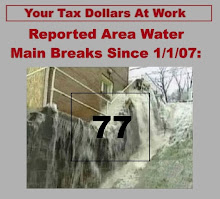
The Admiral over at the Burgh Report informs us of the millions/billions of dollars which will be required to get our sewer system up to Clean Water Act standards. Where will this money come from? Where it always does. The cost will be borne by us and also by us.
All of us will pay ever-increasing sewer rates to fund the rebuild of Alcosan’s underground system. Then all of us will pay a second time when we are required to fix the portion of the “system” that is on our own property. i.e. The sewer laterals that run from our homes to Alcosan’s pipes in the street. Whether we know it or not, WE own the pipes that run from our home’s foundation wall out to the curb. In fact, the individual homeowner is already being compelled to remediate this section of the problem.
Today, in certain city neighborhoods, the individual property owner is required to fix the storm/sewer water problem BEFORE he is allowed to sell his property. (Home, townhouse, condo, commercial property, whatever) City Council passed a Dye Test Ordinance in March of 2006 saying as much. They had no choice. The Clean Water Act federal consent decree trumped everything.
The ordinance name, “Dye Test”, refers to the testing method used to determine if a property’s storm water is “illegally” being funneled into the city’s sewer lines. This test is conducted by a plumber and it costs about $100. The plumber runs brightly-colored dye through the property’s downspouts and storm drains and then checks to make sure he does NOT see the dye running into the city’s sewer lines. If dye is spotted in the wrong place, the property fails its “Dye Test” and the owner must then reroute the storm water.
Where should the rerouted storm water go? The city’s Dye Test Ordinance says it must go to “some appropriate legal place”. And where is that? It’s easier to list where storm water cannot go. It cannot flow down a driveway, cross a sidewalk or flow directly onto another person’ property.
The cheapest and best way to “fix” the problem and still be in compliance with the city’s ordinance is to clip the downspouts which run storm water into street sewer lines. Gutters and downspouts would then be reconfigured so as to direct the rainwater to the property’s back yard. Caution should be taken to make sure your new backyard “pond” is far enough away from your home so as to avoid water problems with foundation walls. If the back yard is not large enough to keep water a safe distance from the home’s foundation, an underground gravel pit could be fashioned or rain barrels could be utilized as a collection point for the rerouted rainwater. This kind of “fix” will cost a few hundred dollars, probably a thousand at most.
And what happens if one has NO backyard with grass, like most homes in Larryville or the Southside? Well, that’s when it gets ugly. If your home is in a section of town that has a “dual system”, meaning both sewer and storm lines in the street, you will be required to pay for a new sewer lateral which connects with the correct kind of pipe in the street. This can cost THOUSANDS of dollars. Communities just outside of Pittsburgh (like Edgewood, Fox Chapel, etc) have been dealing with this expense for years now. In order to be able to sell their homes, these folks have been forking out the big bucks for new sewer laterals.
Unlike our neighbors, Pittsburgh’s sewer system is so old that much of the city DOES NOT have a dual system. For this reason, the more problematic areas like Larryville and the Southside are presently exempt from individual property owner remediation AT THIS TIME. PWSA’s web site has sewer maps for every city neighborhood showing which streets are presently exempt and which streets will require the property owner to bear the cost of Dye Test remediation as a condition of sale. Counter-intuitive as it may seem, “green” streets on PWSA’s maps will require property owner fixes whereas the “red” streets are exempt. AT THIS TIME. When PWSA/Alcosan starts upgrading their lines in the streets, all bets are off as to which streets, if any, will remain exempt.
Were it not for Councilman Bill Peduto’s watchful eye, the situation would be more of a hardship to property owners than it presently is. At PWSA’s prodding, City Council’s original draft of the Dye Test Ordinance required every property on non-exempt streets to have remediations completed and paid for prior to the actual sale of the property. Regardless of the sale price of the property, regardless of the extent or cost of the needed sewer modifications, regardless of the ability of the property owner to pay. That meant some little old lady living on a fixed income trying to sell her modest home for $40,000 to $50,000 had to fork out hundreds-to-thousands of dollars BEFORE she could close on her sale. The catch-22 being she probably needed the money from the sale in order to pay for the modifications that were needed in order to be able to sell.
Much to PWSA’s chagrin and opposition, Peduto amended the ordinance helping folks like the little old lady in the above example. The final ordinance now allows cash from the settlement of a property sale to go into an escrow account and then be used to pay for required sewer modifications which are to be completed within 60 days of closing.
Other onerous ordinance wording changed by Peduto seemed to infer that RENTERS of property with “illegal” storm water connections might be liable for fines levied by the city if the owner of the property failed to make the needed modifications!
Bottom line is that the city has known for decades that a drastic overhaul/rebuild of its sewer system was inevitable. Like the tale of the ant and the grasshopper, all metro area municipalities other than Pittsburgh have been diligently rebuilding their plant. Pittsburgh, on the other hand, chose to busy itself making sure it got a new convention center, a new stadium, another new stadium, and now a new hockey arena.
We do have our distinct priorities. And we will now be paying for them accordingly. Maybe even twice.





1 comment:
Excellent post. I live on the "South Side" (two words) and we've got problems with our roof and rain water.
For years, we have been letting it drip into our house into our walls and running out the basement so as to not go straight to the river. (I'm joking.)
But, this is no joke.
BTW, we are getting a new roof. :)
Post a Comment